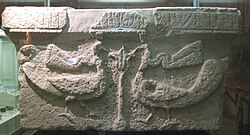Caucasian Albania
Albania, academically termed the Caucasian Albania to avoid confusion with modern-day Albania, is the name for the historical region of the eastern Caucasus. The native name for the country is unknown.[2][3] It was on the land of present-day Azerbaijan and partially Russia's southern Dagestan. The ancient inhabitants of Caucasian Albania spoke Caucasian Albanian, an language that went extinct in the 10th century in the heyday of the Abbasid Caliphate during the Middle Ages.[4]
Caucasian Albania | |||||||||
|---|---|---|---|---|---|---|---|---|---|
| 4th century BC – 8th century AD | |||||||||
![Borders of Arsacid kingdom Caucasian Albania (late 4th century) in the Sassanid empie[1]](https://upload.wikimedia.org/wikipedia/commons/thumb/0/04/Ancient_countries_of_Transcaucasia.jpg/500px-Ancient_countries_of_Transcaucasia.jpg) Borders of Arsacid kingdom Caucasian Albania (late 4th century) in the Sassanid empie[1] | |||||||||
| Status | Empire | ||||||||
| Capital | Kabalak, Partav (modern-day Azerbaijan) | ||||||||
| Common languages | Caucasian Albanian (extinct), Armenian, Parthian (extinct), Middle Persian (extinct) | ||||||||
| Religion | Paganism, Christianity and Zoroastrianism | ||||||||
| Historical era | Antiquity | ||||||||
• | 4th century BC | ||||||||
• | 8th century | ||||||||
| |||||||||
| Today part of | |||||||||
Caucasian Albania Media
A column capital with an Albanian inscription from a 7th-century church in Mingachevir (Azerbaijan State Museum of History)
The ruins of the gates of the Albanian capital Qabala
Roman inscription in Gobustan, Baku, left by Legio XII Fulminata
Departure of Tiridates III of Armenia with the Entourage of Georgian, Abkhazian and Caucasian Albania Kings for Their Christening c. 300. Zakarid church of Tigran Honents, Ani, 1215.
Armenian monk Mesrop Mashtots invented the Gargarean ("Caucasian Albanian") alphabet in the 5th century, after creating the Armenian script (art by Francesco Maggiotto, 1750–1805).
Amaras Monastery in Karabagh, where in the 5th century Mesrob Mashtots set up the first school to use his Armenian alphabet
References
- ↑ M. L. Chaumont, "ALBANIA" in Encyclopaedia Iranica. The Sasanian period. In about A.D. 252-53 Šāpūr I made himself lord of Great Armenia, which was turned into a Sasanian province; Iberia and Albania were also soon conquered and annexed.
- ↑ Robert H. Hewsen. "Ethno-History and the Armenian Influence upon the Caucasian Albanians", in: Samuelian, Thomas J. (Ed.), Classical Armenian Culture. Influences and Creativity. Chicago: 1982, pp. 27-40.
- ↑ Bosworth, Clifford E. Arran. Encyclopædia Iranica.
- ↑ Perczel, Zaza; Aleksidze (October 13, 2011). "The Lost Written Language of the Caucasian Albanians: discovery and decipherment". Center for Eastern Mediterranean Studies, Central European University. Retrieved December 2, 2024.







